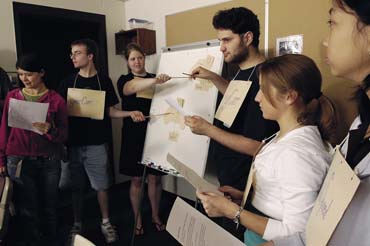Program works to build diverse new generation of computer scientists
A novel freshman-level program at the University of Wisconsin–Madison called Wisconsin Emerging Scholars in Computer Science (WES-CS) is working to counter a remarkable absence of women and underrepresented groups in the field.

Students in the Wisconsin Emerging Scholars program in the computer sciences learn how a piece of Java code works by acting out the different variables. The unique University of Wisconsin–Madison program, led by computer science professor Susan Horwitz, combines active recruiting and mentoring to encourage more women, students of color and students from rural communities to pursue a computer science major. Students in the introductory programming course are (from left to right): Asia Comeau, Daniel Strommen, Stephanie Arndt, David Hoffert, Madalina Tivis and Renata Aryanti.
Photo: Bob Rashid
Professor Susan Horwitz, associate chair of computer sciences at UW–Madison, created the WES-CS program with initial grant support from Microsoft, and now has National Science Foundation backing to continue. The program is combining two core strategies — direct recruitment of new freshman students from underrepresented groups, and parallel team-learning techniques — to the department’s introductory-level course.
Horwitz says those two proven techniques had never been combined in a first-year computer sciences course, and the strategy is helping increase the pipeline of under-represented students and improve their quality of experience once enrolled.
This fall, the program will go a step further with a “First-Year Interest Group” (FIG) built around topics related to computers and real-world problem solving and service. An innovative “Digital Divide” course also will be added that students take simultaneously with the introductory programming course. The class will examine the impacts of technology on different societal groups and will include a group community service project.
Diversity is a tough challenge for computer science. Although science and engineering fields across the board struggle to attract a true cross-section of students, the problem is most pronounced in computer science. At U.S. research universities, typically only about one in 10 computer science bachelor’s degree graduates are women, and the number drops closer to 5 percent at the doctoral level.
“The numbers are terrible for computer science, and they have been trending downward so far this decade,” says Horwitz, noting that UW–Madison women computer science undergraduates have gone from 11 percent in 2000 to 9 percent in 2005.
“No one completely understands the trend,” she adds. “Some of it may stem from the dot.com bust and a sense that outsourcing may be threatening future jobs. But we’re actually looking at a huge pending shortage in the computing workforce.”
Indeed, the U.S. Department of Labor projects that four of the five main computer science employment categories — computer and database specialists, software engineers, support specialists and computer systems analysts — will experience job growth “much faster than the average” through 2014. Only computer programming is expected to be “slower than average.”
Asia Comeau, a computer science student who has been with WES-CS since its inception in 2004, says the dearth of interest in the field among women may stem from the computer science’s reputation as “nerdy” and “boyish.” But there are professional misperceptions, as well.
“Some former (WES) female students said that the reason they didn’t want to continue in CS is they ‘don’t want to end up working alone in a cubicle all day,'” Comeau says.
Horwitz echoed those sentiments. In a survey done of WES-CS after the first year, 12 students said they were originally interested in a computer sciences major but decided against it after the class. Of that group, two-thirds of them had the refrain, “I don’t want a job sitting in front of a computer all day.”
Those comments actually pave the way for opportunity, rather than discouragement, Horwitz says.
“The students were overwhelmingly positive about their involvement in WES, but they frequently followed that up with, ‘I’m majoring somewhere else.’ We hear a lot that they want a career that is relevant. With women and minorities in particular, they are picking careers that will have impact and have ties to their communities.”
Horwitz and others note that computer careers are rich in relevance and impact, but universities have not been actively conveying that message. To that end, Horwitz instituted a dinner and guest lecture program for WES-CS students, inviting in leaders from local computer companies to talk about the profession. The new programs this fall will further reinforce the social impact and benefits of the field.
Horwitz says the freshman-level infusion of practical computer science ideas will help students “gain a better understanding of the breadth of the field, the positive ways in which computer science can affect people’s lives, and the range of interesting career opportunities.”
WES-CS enrolls roughly 50 new freshmen each year. Students receive an extra credit for a one-week, two-hour group session that focuses on fun, interesting exercises well-suited to group problem-solving. This part of the class has proven successful, with 76.5 percent of respondents in the 2005 survey saying the interaction deepened their understanding of the material.
Comeau says another winning feature of WES-CS is the employment of “team leaders” in the classroom, who are actually undergraduates who have been through the program in previous years. Comeau has been both a student and team leader, and says the dynamic creates more of a comfort level in the classroom. Students are more likely to ask questions of an undergraduate peer, for example, than they would a graduate teaching assistant.
“That mentoring relationship, in my opinion, is extremely valuable for women and minorities,” Comeau says. “They have a dependable underclassman to aid in their transition from high school to college life.”




